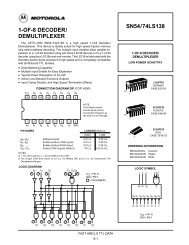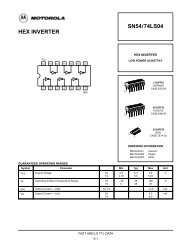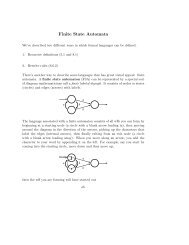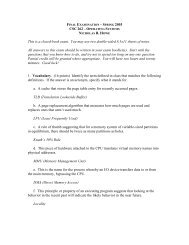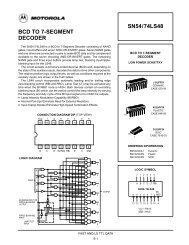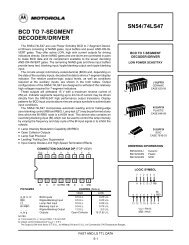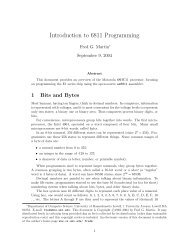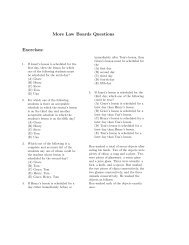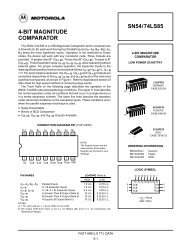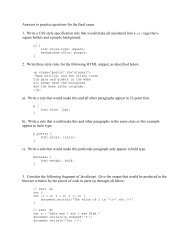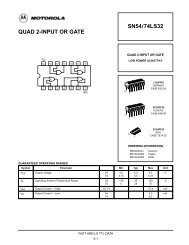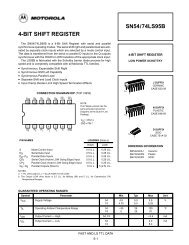Modified Moore method - Smith College
Modified Moore method - Smith College
Modified Moore method - Smith College
You also want an ePaper? Increase the reach of your titles
YUMPU automatically turns print PDFs into web optimized ePapers that Google loves.
THE TEACHING OF MATHEMATICS 487<br />
Appendix I have provided examples of basics as well as questions. .<br />
With the <strong>Modified</strong> <strong>Moore</strong> <strong>method</strong> the class is scheduled to meet as an entire class once a week<br />
for class meetings of 90 to 110 minutes. It does not work well to substitute two 50-minute class<br />
meetings for the one longer meeting, since ample time is required for students to ask questions<br />
about small points. Furthermore, the questions for the week are often intimately related and are<br />
better discussed in a single meeting. Two other hours on two separate days each week are then<br />
scheduled for coaching sessions.<br />
3. Organizing the Class and Assigning Work. The first day of class is devoted to a thorough<br />
explanation of the <strong>method</strong>, its objectives, and what is expected of the students.<br />
The class is then divided into teams of two or three students each. Teams of three work best.<br />
These do not change until midterm when all teams must change for the second half of the term.<br />
New teams are assigned to avoid those consisting only of weak or only of strong students.<br />
At the end of each class meeting the instructor assigns questions for the next class meeting.<br />
Several teams may be assigned the same question. After assigning the questions, the instructor<br />
announces the schedule for the first coaching session.<br />
The assignment is to work as a team to: 1) understand the question, 2) find the answer, and 3)<br />
write a short paper presenting the question and its answer. This paper will be duplicated and<br />
distributed to all members of the class. In addition, each team must be prepared to explain to the<br />
class its question and the answer it has found. All teams are expected to be prepared for each class<br />
meeting, although only one team per question will be called upon to make an oral presentation.<br />
4. The Coaching Sessions. The first coaching session follows the class meeting by one or two<br />
days. Each team is required to come during that part of the first coaching session dealing with its<br />
question. If several teams are dealing with the same question, all of those teams come at the same<br />
time. Each team is expected to have met once prior to this session to try to understand the basics<br />
and the question and to formulate ideas about the answer.<br />
When students have discovered the answer before the session, the instructor simply listens to<br />
the team's answer and provides whatever help is necessary to make the team's explanation very<br />
clear. When a team comes in a state of confusion, on the other hand, the instructor must do some<br />
explaining. In the 20 or 30 minutes devoted to each question, he must try to lead the students to<br />
the heart of the matter, using a Socratic style as long as time permits it. Sometimes this means<br />
asking one or two questions to help students understand how they almost had the idea themselves.<br />
At other times it means giving a complete explanation, and hoping that the students will make a<br />
discovery on some other questions. I try to make sure that at least one member of each team has a<br />
basic understanding before the teams leave.<br />
The second coaching session follows the first by three days or more. During those days the<br />
students prepare drafts of their papers. The teams meet and discuss the work and a team might<br />
even agree on a rough written draft of its paper. Each member must then write his or her own<br />
draft without consultation.<br />
All teams gather for the second coaching session during which students exchange their drafts<br />
- with their teammates for peer review. The reviewers pay close attention to content, clarity and<br />
style, and make suggestions for improvement.<br />
While this peer review is taking place, the instructor selects drafts at random and reviews them<br />
in front of the team. This provides at least one team member with professional comment on a<br />
draft, and at the same time gives each member a chance to watch how the instructor reviews. I<br />
reserve some time to speak to the class as a whole about common errors or misconceptions found<br />
during my reviews.<br />
5. The Weekly Papers. Each paper must consist of a clear, concise, cogent answer to the<br />
team's question for the week, written in a style appropriate to the subject for the course, and with<br />
careful attention to syntax, punctuation and correct usage of notation commonly used by




